A Guide to Selecting the Best Home CCTV Cameras
Help selecting camera type, resolution, lens and features16/09/2018 Nathan Owen 6388
As CCTV becomes more accessible and affordable, more and more people are looking to install a home CCTV system. Images and stories in the media have raised public awareness about CCTV and how effective it can be at preventing and solving crime while advancements in technology have made CCTV systems more effective than ever.
Smart home technology has introduced a new type of CCTV system that uses small and often wireless indoor and outdoor cameras that can be easily set up and viewed on mobile devices. These smart home CCTV systems however often have limitations including low image resolution, short battery life, reduced low light performance, poor weatherproofing, lack of vandal resistance and limited range.
For people looking for a more advanced home CCTV system that offers the quality and features of a commercial CCTV system there is a wide range of plug and play hard wired systems that are compatible with a broad selection of different cameras.
This guide aims to help people looking for a more advanced CCTV system to select the right cameras for their requirements and helps to explain the technology and features found on the most common types of cameras available.
Selecting the type of camera

Rewind the clock 20 years and the majority of CCTV cameras were box style cameras. This was mainly due to the technology that was needed to make a CCTV camera requiring a large housing. These types of cameras could be used indoors or outdoors with a suitable enclosure.
Over time modern advances in technology enabled the components of a CCTV camera to fit into smaller housings and as a result the dome style cameras became popular. Dome cameras offered a number of benefits including a camera and housing all in one that could be mounted horizontally or vertically and that was also very tamper and vandal resistant. Originally dome cameras like box cameras though did not perform well in low light so manufacturers started to add infrared LED's that enabled a camera to see black and white images in almost complete darkness.
Bullet cameras also became popular around the same time as dome cameras as they had larger all-in-one housings with long range lenses and more powerful infrared LEDs for better images over greater distances.
More recently a new style of camera called an eyeball or turret has become popular. The turret style camera aims to combine the best features of a dome and a bullet into one and at the same time eliminate some of the problems associated with dome and bullet cameras.
There is a wide range of different types of CCTV camera available and many are designed with a specialist application in mind such as number plate recognition, covert, thermal or fisheye cameras. Typically, the more specialist cameras are used for commercial applications so we have only detailed the more common types below.
Dome Cameras
Advantages
- Vandal resistant design
- Compact size
- Discreet appearance
- Less obvious which way the camera is facing
Disadvantages
- Curved surface causes glare
- Rain reduces visibility
- Polycarbonate dome covers lose clarity over time
Best for
Use where discretion or vandal resistance is required and indoors or in sheltered areas.
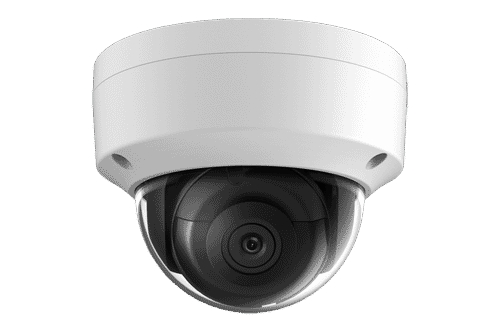
A dome camera has a curved glass or polycarbonate (tough transparent plastic) cover over the lens to allow full visibility throughout the camera's range of adjustment. This design makes the camera very tamper proof with no surface that is easy to get hold of and it is still the best solution where the camera is mounted low down or is at risk or being vandalised. Dome cameras are also popular for their discreet appearance and for the fact it is harder to see where the camera is viewing. Dome cameras are a good choice for use indoors.
Dome cameras have some issues though and one problem with the design of the dome camera is that curved surfaces cause glare when exposed to bright lights like sunlight and car headlights. Dome cameras can also experience glare from their own IR LED's which can reflect back onto the lens from the inside of the cover. Another issue caused by the curved surface is that rain can run over the surface when mounted vertically on a wall causing distortion. This is even more apparent at night when the cameras own IR LED's can reflect off the rain droplets on the cover. This can be prevented by mounting domes upside down on a horizontal surface and ideally where they are partly sheltered such as under a porch or soffit.
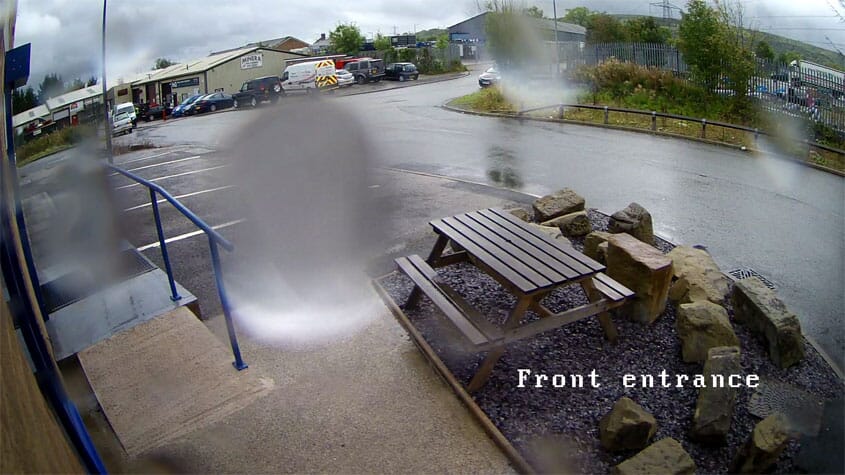
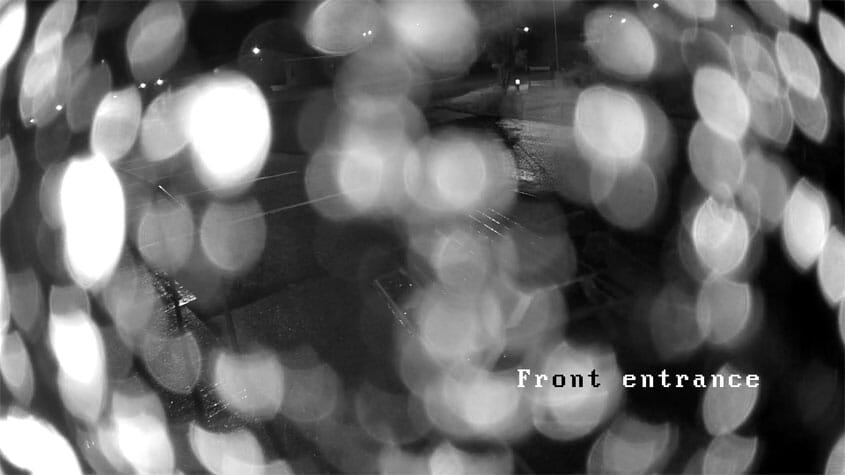
Bullet Cameras
Advantages
- Large visual deterrent
- Longer range IR LED's and lenses
- Wide range of mounting options
Disadvantages
- Less vandal resistant
- Problems with spiders
- Less discreet
Best For
Use on commercial buildings, high up and for viewing scenes further away.
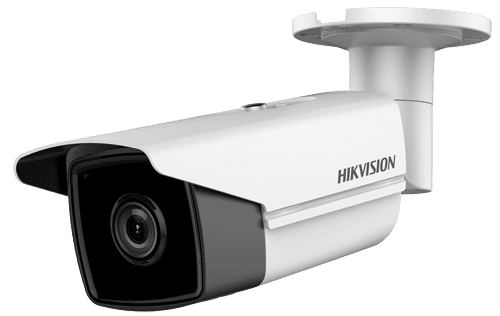
Bullet cameras are larger box shaped cameras that have an adjustable bracket that allows them to be mounted horizontally or vertically. They often have more powerful IR LED's and telephoto lenses for viewing objects and scenes further away. Bullet cameras are very noticeable and provide an excellent visual deterrent.
Many bullet cameras have sun shields to prevent glare from the sun which can be especially noticeable on cameras with greater focal lengths. While useful the sun shield can be a disadvantage as spiders are attracted to the warmth from the IR LED's and make webs under the sun shield that results in the IR LED's reflecting back onto the lens which blocks the cameras' view.
Although some manufacturers offer bullet cameras with wide angle lenses they are better suited to longer focal lengths.
Bullet cameras are also less vandal resistant and can be easily forced out of position which may cause the bracket to break or become damaged.
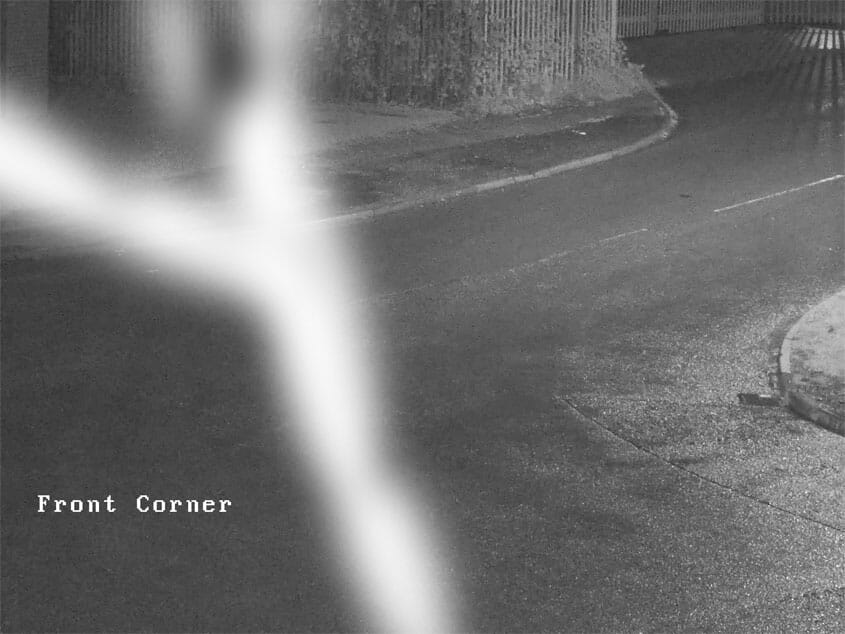
Turret / Eyeball Cameras
Advantages
- No IR reflection
- Suitable for all weather conditions
- Discreet and compact
Disadvantages
- Obvious which direction the camera is facing
- Not completely vandal proof
- Limited IR / Focal range
Best for
Most general CCTV requirements, average mounting height and viewing wide areas
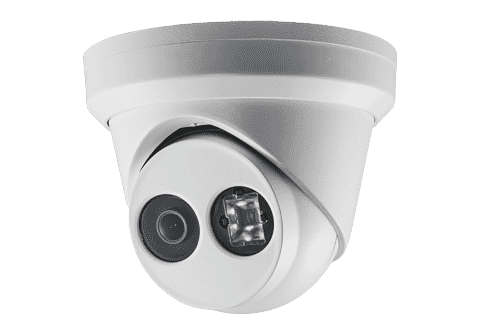
The turret or eyeball style camera was designed to eliminate the issues with dome cameras while still retaining some of their more useful design elements. Turret style cameras are a ball and socket design so can be freely adjusted to view any angle when mounted horizontally or vertically. Their flat face reduces glare and IR reflection and the small lens area can be easily made of glass rather than Polycarbonate which does not discolour or become brittle over time.
Turret cameras are still reasonably discreet and compact and usually have wide angle lenses with no sun shields making them less likely to attract spiders.
The design of a turret camera is more vandal resistant than a bullet camera although not completely vandal resistant like a dome would be. This makes them better suited to mid-height installation where they are out of direct reach. They are also less popular in public areas as the direction the camera is facing is very apparent, which can make them feel more invasive to members of the public.
PTZ Cameras
Advantages
- Very long focal length / zoom range
- Powerful IR LED's and good low light images
- Can be controlled remotely
Disadvantages
- Large and not at all discreet
- May miss things if facing the wrong way
- Expensive and harder to install
Best for
Commercial applications covering large areas and where the camera will be operated manually
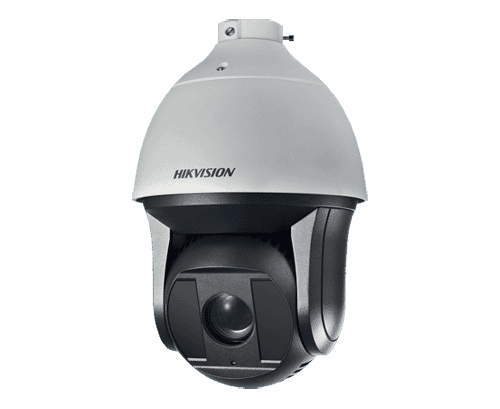
While PTZ cameras are more common on commercial applications, smaller and cheaper versions are starting to find their way onto home CCTV systems.
PTZ cameras are physically larger and as such can house larger lenses and image sensors. The result of the large optics is that professional PTZ cameras often provide very clear images both day and night. They can often have long range telephoto lenses and very powerful IR LEDs with a range well in excess of 100 metres.
A PTZ camera can be rotated up to 360° as well as tilted up and down and zoomed in and out remotely making them very versatile. This does mean however that if the camera is left pointing in one direction focused on something specific it cannot see or record the rest of the scene that is out of shot.
Due to the complexity of the moving parts and the powerful optical set up PTZ cameras are often significantly more expensive than fixed cameras. It is often cheaper to buy multiple fixed cameras in place of a single PTZ camera and where the camera will not be regularly operated it is usually better to do this.
Selecting the Best Lens
Fixed cameras such as domes, turrets and bullets are available with vari-focal or fixed lenses. Fixed lens cameras cost less and are often smaller as there are fewer parts required.
A vari-focal camera can be zoomed in and out to achieve the desired viewpoint. This can be done manually with adjusters on the camera or where a camera has a motorised lens, they can be adjusted remotely using the recorders software. Typically, a vari-focal lens will offer a range from a wide angle (e.g., 2.8mm) to a more zoomed in angle (e.g. 12mm).
A camera with a fixed lens may be available with either a 2.8, 4.0, 6.0 or 12mm focal length although this varies across different manufacturers.
The images below show a wide angle shot and the equivalent image from a much more zoomed camera in the same area.
While a wide-angle image gives the best overall coverage of an area, objects in the distance are often too small to identify. A camera with a longer focal length is better for identification of objects further away but will provide less coverage of an area. Typically, a 2.8mm lens will give a coverage angle beyond 90° which makes it better suited for an overview of an area or where the subject will not be far from the camera.
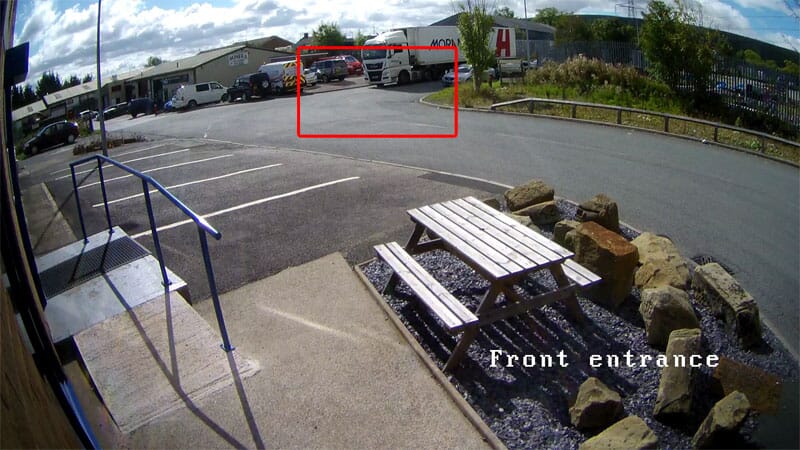
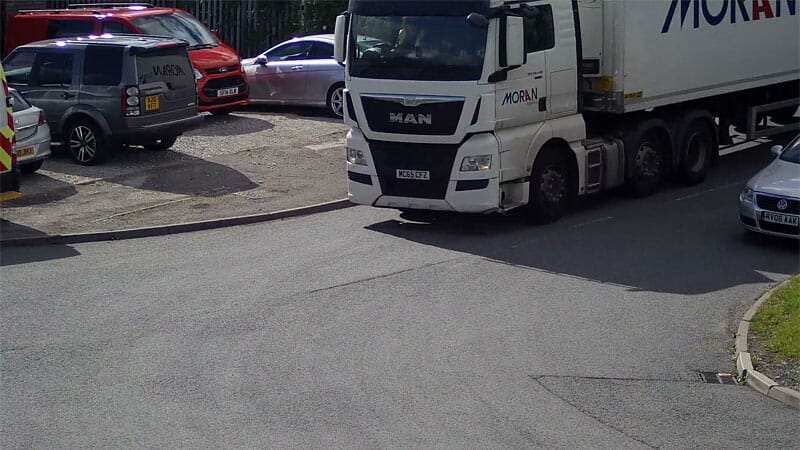
Selecting the Right Resolution
Modern CCTV cameras are available in a variety of resolutions with higher resolutions giving more detail than lower resolutions. It might seem obvious to simply select the highest resolution available but there are other considerations that may affect that decision. Resolutions are available anywhere from 1.3 Mega-pixel up to 8 Mega-pixels. 2 or 3 Mega-pixel resolutions are often referred to as HD or Full HD and 8 Mega-pixel resolutions are known as 4K. While higher resolutions are possible and available, they are usually reserved for specialist cameras.
Image Detail
Image detail is the obvious difference with camera resolution. High resolution images have more detail and this can mean smaller objects are easier to identify. Prior to HD images becoming the standard CCTV resolution were designed for standard televisions and monitors and were only equivalent to 0.4 Mega-pixels. As such any HD CCTV upgrade will appear significantly better than older technology.
Data Storage
In order to hold more detailed high resolution images, have larger file sizes so storing high resolution images and video takes up more storage space. It is important to calculate how much storage your cameras will use so you can be sure that your system will record for as long as you need. While you might expect over a week's recordings from 4 x 2 Mega-pixel cameras on a 1TB hard drive this will reduce to around a day if you use 8 Mega-pixel cameras. There are lots of factors other than resolution that affect how much data you can fit on hard drive including frame rate, compression, bitrate and the amount of movement detected.
The file sizes for the actual captured images shown below are as follows
- 0.3 Mega-pixel image 0.07MB
- 1.3 Mega-pixel image 2.21MB
- 4.0 Mega-pixel image 8.57MB
- 5.0 Mega-pixel image 12.31MB
- 8.0 Mega-pixel image 16.70MB
Cost
Quite simply higher resolution cameras cost more so you may need to consider your budget and the desired purpose of the CCTV system to help decide which resolution to opt for.
Coverage Area
A higher resolution camera gives more detail for smaller objects further away. If you have selected a wide-angle camera to cover a large area, consider a higher resolution to ensure that you can identify smaller objects. If the camera is being used indoors or to view a smaller space there may be no benefit to a high-resolution camera.
In the images above a high-resolution camera would offer very little extra over the 2 mega-pixel camera used to capture the 12mm shot whereas in the 2.8mm scene a high-resolution camera would be beneficial to identify objects in the distance.
Examples
The image below accurately shows the scale of the change between the same image taken from the same camera captured at different resolutions.
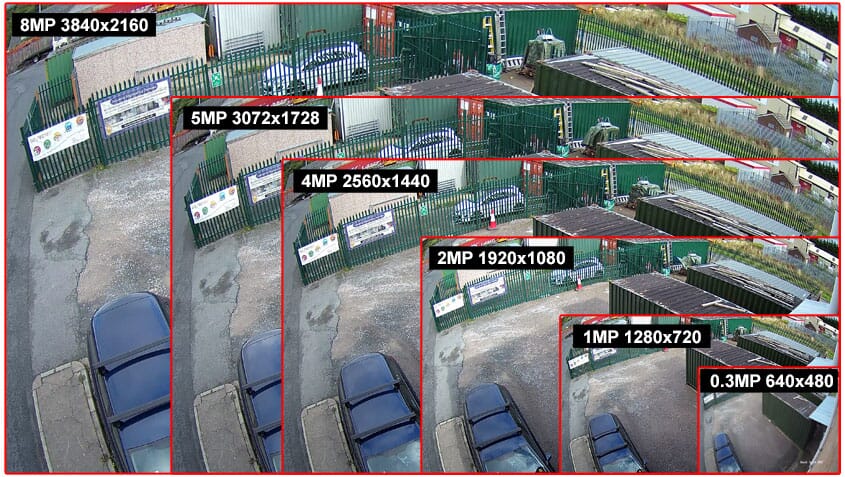
The sequence of images below shows the amount of detail captured for the same object at each of the resolutions.
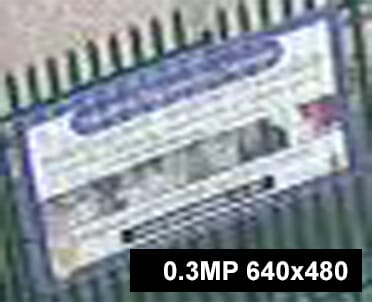
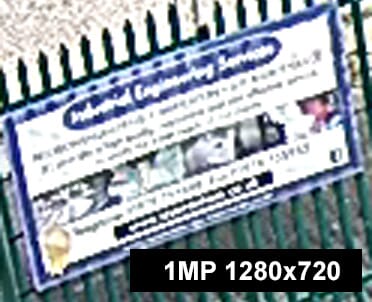
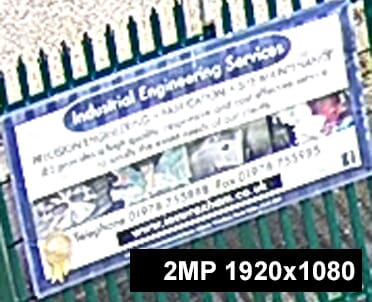
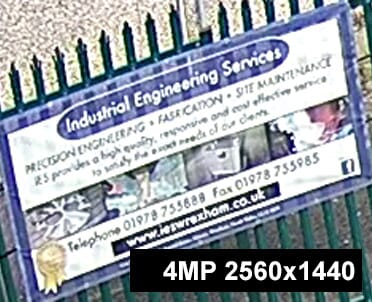


Analogue (TVI, CVI, AHD) vs Digital (IP, Network)
When we refer to analogue or digital in relation to CCTV, we are referring to the video transmission method and not the recorder. Most CCTV recorders have been using digital technology to store images for quite some time now.
Analogue CCTV systems use traditional cables such as Coax to transmit the images as a video signal which the recorder converts to data. Digital CCTV systems convert the images to data in the camera and transmit the images as data which is stored directly by the recorder.
A camera for a digital or IP Network CCTV system may cost slightly more as it is required to carry out conversion directly within the camera. The advantage though is that data is more versatile and less prone to interference and can be easily sent over wireless (Wi-Fi) of via a local area network which can be distributed using Ethernet switches allowing multiple cameras to use a single connection.
IP Network cameras also benefit from PoE technology which means power and data can be sent over the same cable making installation simpler and potentially lower cost. While PoE technology has recently become available for analogue systems its use is not widespread and interference can cause loss of power as well as image distortion. Most analogue cameras require separate power supplies and power cables which can make installation complicated and more expensive.
Analogue cameras are usually cheaper although as the recorder is carrying out the conversion, processing power restrictions mean recorders for larger analogue systems may cost more than their IP network equivalents. Analogue cameras can also take advantage of existing cabling which can save installation costs.
In modern installations larger systems are often installed using digital IP technology with smaller systems being installed either way depending on budget, cabling and complexity.
Conclusion
There are lots of other factors and camera types not covered here but hopefully the information provided should help you on your way to selecting cameras for a simple home or small business CCTV installation.
Often the decision comes down to budget so try adding the components you need to your basket and saving it as a quote. That way you will be able to compare the costs involved with different types of systems.
While there are scenarios where each type of camera is better the newer turret style cameras are a good balance and cater for most home CCTV requirements. Typically, 2 or 4 Mega-pixels is a good choice for resolution as it offers a good balance of price vs quality although higher resolutions may be useful for large areas.
A 2.8 mm lens is currently the most popular choice with many people opting to cover as large an area as possible although a 4.0mm lens will give more detail while still offering a reasonably wide view.
An IP network system is more versatile and easier to install than an analogue CCTV system but existing cables or budget constraints might mean analogue is the best path in some cases.
If you are still undecided about which cameras you need you can call and speak to one of our specialists who will be happy to offer pre-sales advice and also after sales support to ensure you get the best from whichever camera you select.

About Nathan Owen